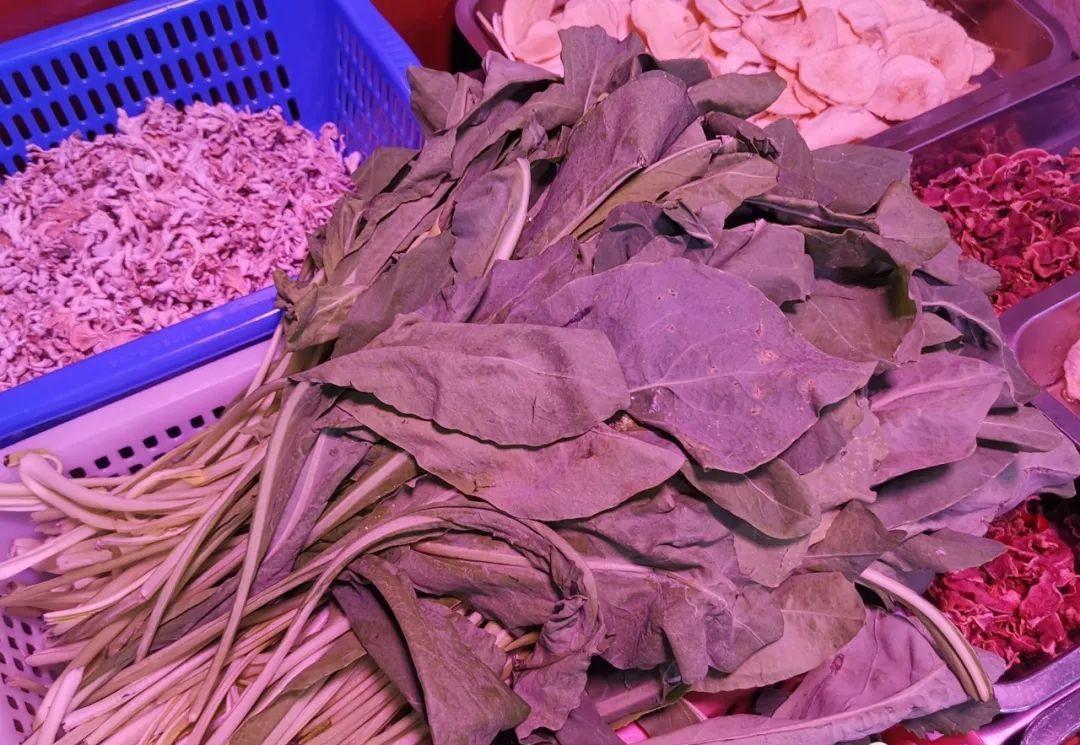One evening last year, I had dinner at a humble little restaurant in Kunming. Although it is a small shop, for the northern nephews who have never seen the world, it is full of "rare treasures", and various "wild vegetables" make the brick family fall like a cloud of five miles. The people of Yunnan are too rough, they catch what they eat.

Figure 1
For example, the "dish" in the picture above, it is frightening to say it. This is the leaf of the cruciferous plant Pineapple / Isatis indigotica Fortune, according to chinese medicine, the root of pineapple is the "plate blue root" that covers all diseases, and the leaves are "big green leaves". It is rumored that "Big Aoba" is mainly used to treat various sores and carbuncles, but here is the life of being fried. Xiao Gong did not like to eat vegetarian, but out of curiosity, he still ordered this dish, and the chef forgot that he had eaten 90% at that time, so he canceled it on the slope. A bit of a pity.
Figure 2 The color rendering of the kitchen lights is not good, and it is a little discolored
Figure 3
After eating that night, I went to the back kitchen to explore and found a wild vegetable that was completely confused, looking hairy and tied, and seemed to have nowhere to put my mouth. What kind of plant is this? Judging from the morphology of the leaves, it is a palmate compound leaf, leaflets or 3 or 5, judging by general common sense, this thing seems to belong to the Pentagram family. At that time, I asked the clerk, Yi threw me three words and turned away, but I did not understand; later, after several memories and speculations, I "tossed and turned, and I was convinced", feeling that Yi said something like ---- and thorn five plus.
Figure 4 Eleutherococcus, Yichun City, Heilongjiang, photographer Dong Shang
Figure 5 Eleutherococcus, Changbai Mountain, Jilin Province, photographer Zhou Xuan
It seems to make some sense to say that it is Eleutherococcus, the family Pentagram, the petiole obviously has spines, but it is not "Eleutherococcus senticosus (Ruprecht & Maximowicz) Maximowicz in the Flora of China. This species is mainly produced in the northeast, Heiji liao, but to the south is not Hebei and Shanxi, and it is unlikely to appear inexplicably in the southwest direction. BTW, the young stems and leaves of Eleutherococcus senticosus are also regarded as "mountain treasures" wild vegetables by Northeasterners, and are often sold in spring markets.
Figure 6 Bai Gui, Guiyang City, Guizhou, photographer Tian Qin
Figure 7 Bristle White Curtain, Conghua City, Guangdong Province, photographer Sun Guanling
Unrecognized plants are like unsolved murders, I have been watching various clues related to each other, and finally in the past few days I have come close to the correct answer, this plant, which is mistakenly called "Eleutherococcus" by the Yunnan people, is most likely a close relative of its family, Bai Gui/E. Trifoliatus (Linnaeus) S. Y. Hu or Bristle White Gui/E. setosus (H. L. Li) Y. R. Ling. Looking closely at Figure 3, the small leaves have long bristles, and the latter is more likely. p.s. The Zhongzhi treats the latter as a variant of the former (hereinafter collectively referred to as "Bai Gui").
From figures 4 to 7, the difference between eleutherococcus and baizhi is more obvious, the former is "leaflet 5, thin 5", the latter is "leaflet 3, dilute 4, 5", so the white leaf has the common name "three plus skin", "three leaves five plus". The name of baiyi may be relatively unfamiliar to the average person, but this plant is widely used in the south and is not unique to Yunnan people. For example, the "Enping vegetables" that you are a "national geographical indication for agricultural products" is this thing, there is large-scale artificial cultivation in Enping, in addition to being a seasonal vegetable, it can also be made into "vegetable tea", which is well-known in the Lingnan area, and the old Guang people prefer to call the white straw as a grass palm or goose palm.
Fig. 8 Bitter pork balls
Netizen "Huajian Xiaodian" opened an online store specializing in food, and every Qingming Dynasty, it launched a local cuisine called "bitter thorn pork balls", "bitter thorn" that is, "Chaoshan bitter thorn", in fact, it is still a white thorn, not a "bitter thorn flower (white thorn flower)" that Yunnan people often eat. According to her, the conventional products of the food factory must be filed, and the agriculture and forestry department has issued a list of edible wild vegetables that can be added to the food, with white thorn flowers but no white grain, which she took from a licensed vegetable manufacturer in Enping. It can be seen that wild vegetables are similar to the so-called "wild animals", and they cannot be sold if you want to.
Whether it is white or eleuthero, the entrance will feel a little bitter, which is also a common feature of "wild vegetables", whether it will "return to sweetness soon", it is always bitter. Bitterness usually means a risk of poisoning, and occasionally it is not necessary to taste it, and if you have to think that wild vegetables are more conducive to good health, it is the opposite. Over。